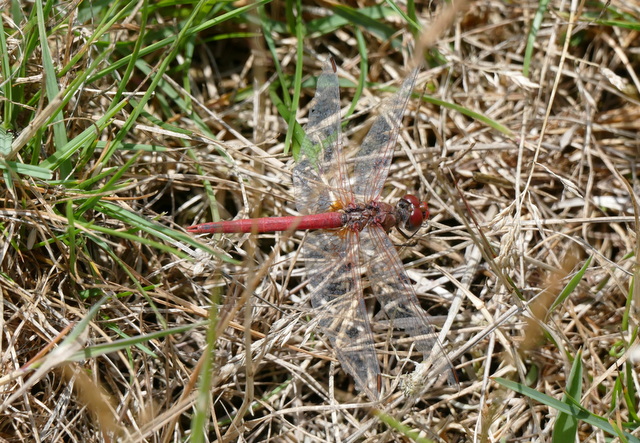Day 2 of a long weekend of tours today. The itinerary saw us looking for Spoonbills and Dartford Warblers, which the weather did its worst to thwart. It was wet and very windy in the morning – gusting to 45mph. It brightened up in the afternoon, though the wind didn’t really start to drop until much later on. As ever, despite the weather we had a really good day and saw lots of really good birds!
We would originally have gone up to the Heath to look for Dartford Warblers in the morning, but it was really not the weather for it today. Instead, we decided to seek the shelter of the hides at Cley first thing. After the heavy rain overnight (we had about a month’s rain in 24 hours), the water levels on the scrapes had risen considerably. However, there was still a very good selection of birds on view.
We headed to Teal Hide first and had a look at Pat’s Pool. Two small waders were feeding around the edge of the largest island. The adult Dunlin was immediately obvious, with its striking black belly patch, but the second bird was a source of potential confusion for the uninitiated (and indeed it did cause some amongst some of the other people in the hide). Similar in size to the Dunlin, but with a shorter, straight bill and bright, white underparts, it was a summer plumage Sanderling. We are more used to seeing them running in and out of the waves on the beach in the winter, by which stage they are silvery grey above and white below. An out of place Sanderling has confounded even the experts in the past. This one was presumably seeking somewhere sheltered to feed.
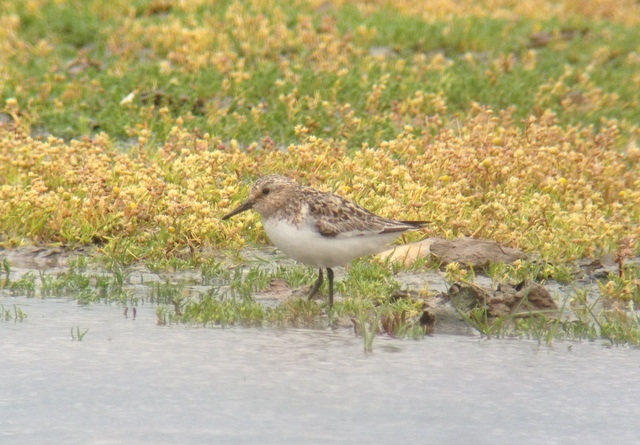 Sanderling – a summer plumage bird on the scrape
Sanderling – a summer plumage bird on the scrape
There were sandpipers too. A Green Sandpiper flew in from the east and dropped in to the vegetation at the front of the scrape. We could see its very slaty-grey upperparts and blackish underwings, with contrasting white tail as it landed. A Common Sandpiper flew in as well, and landed on the muddy edge right in front of us.
 Common Sandpiper – landed briefly on the mud in front of the hide
Common Sandpiper – landed briefly on the mud in front of the hide
Unfortunately, neither of the sandpipers hung around for long. Avocets are not particularly good parents, but a couple of pairs still have juveniles on Pat’s Pool at the moment. Their idea of childcare is to mostly ignore their ‘children’ but chase off any potential predators. They are good at trying to chase after Marsh Harriers, but not quite selective enough in their choice of target – they attempt to chase away anything which comes into range. So the sandpipers were seen off, and a couple of Teal, and the Dunlin and Sanderling when they dared to venture along the front of the island. All obviously grave threats to a juvenile Avocet! Needless to say, the survival rate amongst juvenile Avocets is not great.
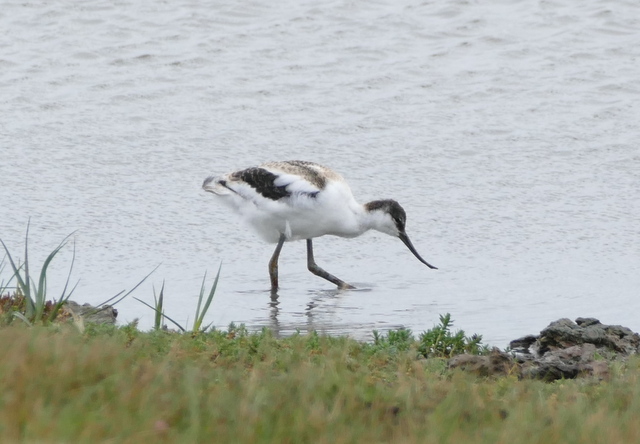 Avocet – a well grown juvenile; its parent chased off most of the other waders
Avocet – a well grown juvenile; its parent chased off most of the other waders
When not chasing off anything which comes into range, the adult Avocets will occasionally shelter the juveniles, but only when they are very small. The older juvenile on the scrape was the only surviving youngster of one pair, and had to fend for itself in the rain. The other Avocet pair had three much smaller youngsters and they were allowed to shelter under one of their parents in the worst of the weather.
 Avocet – one youngster out, the other two hiding underneath
Avocet – one youngster out, the other two hiding underneath
There were gulls and terns already roosting on the islands when we arrived, tucked down out of the wind and rain. Six Little Gulls were feeding together in the wet grass, picking at the vegetation for invertebrates, all of them 1st summer birds born last year. Nearby, two Common Terns and three Sandwich Terns were trying to sleep through the weather, which would make fishing difficult for them.
There were big gulls too – and more dropped in to join them while we were there. As well as the ubiquitous Herring Gulls, several Great Black-backed Gulls had retreated from the shore and in amongst them were two smaller and slatier-backed Lesser Black-backed Gulls. A single juvenile gull appeared with them as well and a close look revealed it to be a juvenile Yellow-legged Gull, presumably a post-summer dispersing bird from the continent.
We headed round to Dauke’s Hide next and had a look at Simmond’s Scrape. There were more larger waders here. A big group of Black-tailed Godwits were trying to sleep on one of the islands – we could see a mixture of rusty adult birds and grey 1st summers. There were also several Ruff, once again in a wide variety of different plumages. The males are very variable in summer plumage at the best of times, and they are also now in various stages of moult as well. The significantly smaller females can look rather different again.
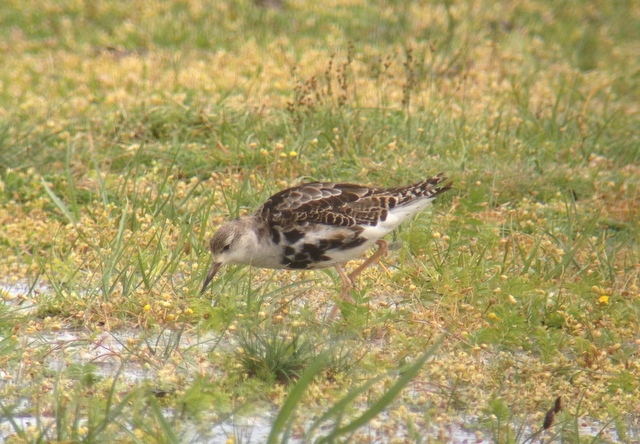 Ruff – a male moulting into winter plumage
Ruff – a male moulting into winter plumage
All the while we were there, birds were constantly dropping in. A couple of bright orange summer plumage Knot flew in with a Golden Plover. The Knot were promptly seen off by one of the Avocets! A few more Golden Plover arrived until there were five feeding on the grass together. A Ringed Plover dropped in briefly, before flying on west; a short while later, a Little Ringed Plover did much the same. A Common Snipe dropped in and started feeding in the wet grass. A Whimbrel flew over, calling.
There was no sign of the Spoonbills at first today. They were probably hiding somewhere more sheltered. However, while we were in the hides, two Spoonbills dropped in to the scrapes. The shorter-billed juvenile landed on one of the islands and tried to find somewhere to roost out of the wind, but the other bird continued on towards North Scrape. A short while later the juvenile decided it was not a great place to sleep today and flew off as well.
 Spoonbill – this juvenile dropped in to Simmond’s Scrape briefly today
Spoonbill – this juvenile dropped in to Simmond’s Scrape briefly today
There were other birds to see was well. One of the female Marsh Harriers spent ages flying low over the reeds along the back of Simmond’s Scrape, but presumably hunting was difficult today and she seemed to achieve very little. A juvenile Yellow Wagtail landed on of the islands briefly, before flying down to the grass round the edge of the scrape and disappearing from view.
Late morning, we decided it would be a good idea to head back to the visitor centre and get a hot drink to warm up. Afterwards we drove round to the beach car park. Given the gale-force NNW wind, and the approaching high tide, the waves were crashing into the beach. It was great to watch and we stood for a while on the stones marvelling at the power of the sea. Several Gannets passed by offshore.
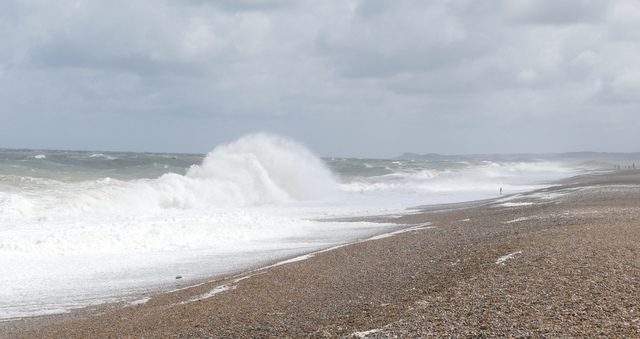 Cley Beach – the waves were crashing onto the shore today
Cley Beach – the waves were crashing onto the shore today
It had stopped raining by this stage, but we still took advantage of the beach shelter to get out of the wind and seaspray and enjoy an early lunch. There had been a few different waders out on North Scrape in the morning, so we decided to walk and take a look ourselves.We were at least walking with the wind at our backs, but there were few birds around today. A Skylark sat in the Eye Field watching us.
As we were walking over the grass, a dragonfly flew up in front of us and landed again a bit further along. Unusual out here at the best of times, this was hardly the weather for dragonfly watching! Still, we managed to find it sheltering in the grass below the fence line and discovered it was a rarity to boot – a smart male Red-veined Darter. There has been the odd one around the reserve in recent weeks, but it was not something we were expecting to find out here, least of all today!
Red-veined Darter – a surprise in the Eye Field, particularly given the gale!
Unfortunately, as we arrived at North Scrape, something had just spooked all the waders. There were now fewer on show than there had been. However, we still managed to find a Curlew Sandpiper hiding amongst several Dunlin. Its chestnut underparts, dappled with white as it moults into winter plumage, gave it away – very different from the black belly patch of the adult Dunlin. There were also several more Little Ringed Plovers, Ruff and another Green Sandpiper out here today. A big group of Sandwich Terns were sitting out the stormy conditions on one of the islands.
We headed round to the East Bank next. It was still very windy, but at least the clouds had cleared and it had brightened up. It was rather blustery on the walk out along the East Bank – not the weather for Bearded Tits today. However, out at Arnold’s Marsh we walked down the steps and got ourselves in the lee of the bank.
There were lots of waders out on Arnold’s Marsh. There have been groups of Knot out here for several weeks. There have been more grey 1st summer birds, but today the majority were adults already returned from the north, sporting bright orange underparts. Amongst them were two more Curlew Sandpipers, slightly richer chestnut below and darker brown above, more dainty with a longer, finer, downcurved bill.
There were lots of smaller Dunlin and Sanderling here too. One of the Dunlin stood out – with much brighter rufous upperparts, paler face and a more contrasting black belly. There are several races of Dunlin all around the world, breeding from the Pacific coast of North America to far eastern Siberia, and they vary subtly in appearance. This was perhaps a Dunlin from further east.
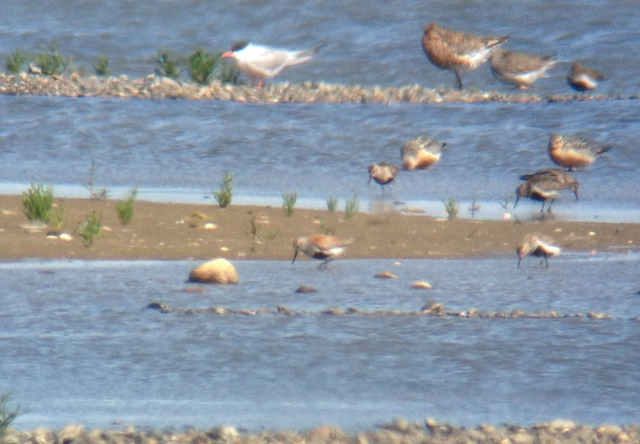 Dunlin – an interestingly bright bird with other waders on Arnold’s Marsh
Dunlin – an interestingly bright bird with other waders on Arnold’s Marsh
The more we looked, the more we found. There were some very smart Turnstones, still in summer plumage with white faces and bright rufous backs. Most of the godwits were asleep on the islands, tucked down in the vegetation. There were lots of Black-tailed Godwits, but two Bar-tailed Godwits came out to feed, allowing us to get a much better look at them.
There were lots of terns as well. The Sandwich Terns regularly loaf out in small numbers around Arnold’s Marsh, especially at this time of year, however many more seemed to be sheltering from the wind today. Amongst them we could see lots of Common Terns and even a couple of Arctic Terns as well.
By the time we got back to the car, it was almost time to finish but we had still not been up to the Heath. Realistically, despite the wind having dropped somewhat it still seemed a little too windy but we headed up there anyway on the off chance. It seemed rather quiet as we got out of the car. At least the sun was shining and, in a couple of sheltered spots, we finally found some butterflies as we walked out, mostly Gatekeepers and Meadow Browns.
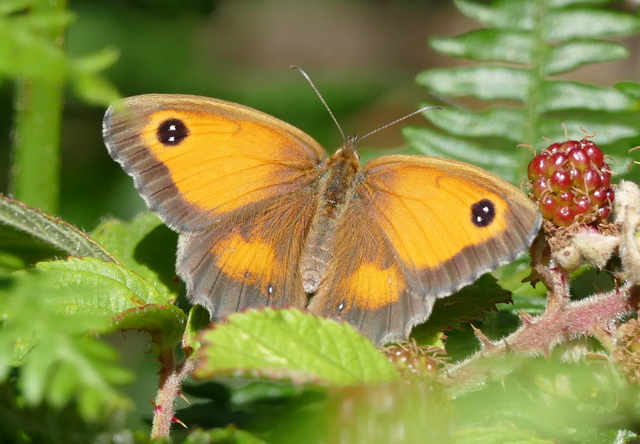 Gatekeeper – there were lots of these out on the Heath this afternoon
Gatekeeper – there were lots of these out on the Heath this afternoon
We flushed a couple of Linnets from beside the path as we walked, and we could hear a Yellowhammer singing. We were not surprised to find no sign of the Dartford Warblers around one of their favoured area – they really don’t like windy conditions. We carried on across the Heath and a Turtle Dove started purring briefly behind us, in the area we had just walked through. Unfortunately it stopped again as soon as it started, and we didn’t have enough time to work out where it was hiding.
As we rounded a corner on a normally quiet corner of the Heath, we came across a large puddle across the path. A male Yellowhammer flicked across and landed in the grass in front of us, eyeing us nervously. It was obviously looking to come down to the puddle and eventually plucked up the courage to hop down to the water’s edge, and then start to bathe. The Heath is normally very dry, so this was perhaps a rare treat.
 Yellowhammer – bathing in a puddle
Yellowhammer – bathing in a puddle
While we were watching the Yellowhammer, we heard a harsh churring call in the gorse right next to us. The next thing we knew a Dartford Warbler flew out across the path in front of us. Just for second it seemed like it might dip down towards the Yellowhammer, but it seemed to see us standing watching it and fly up into the vegetation instead. Unfortunately, just as we were hoping it might come out again, two walkers appeared and came straight past us along the path. We decided to move on. We had really not expected to see Dartford Warbler today, and this is not one of their usually favoured places, so it was a real stroke of luck to see one today.
 Grayling – basking on a concrete post, camouflaged against the stones
Grayling – basking on a concrete post, camouflaged against the stones
We had a quick walk round the rest of heath, but it was rather quiet. We did add a couple more butterflies to the day’s list – Grayling and Essex Skipper. And we did run into a large mixed tit flock working its way through the birches. But then it was time to head back and get something to eat ahead of the evening’s entertainment.
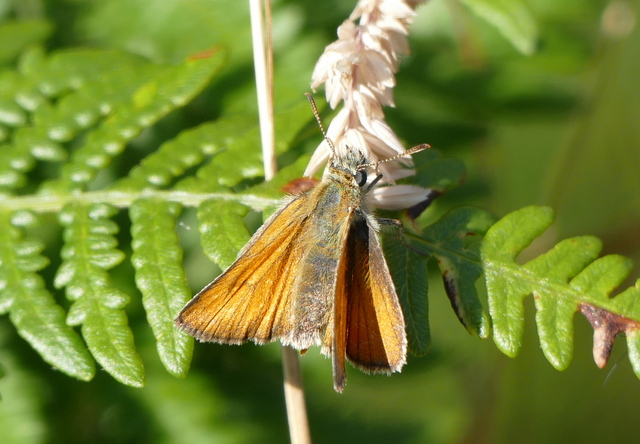 Essex Skipper – with blackish-tipped antennae
Essex Skipper – with blackish-tipped antennae
Nightjar Evening
We met again in Holt in the early evening, after a break to recover from the day’s exertions and a chance to get something to eat. We dropped down to the coast first. A quick drive round the grazing meadows and we found our first Barn Owl of the evening perched on a fence. We stopped the car and got it in the scope. A great start! It flew off and resumed hunting around the grassy fields. A couple of Whimbrel were calling overhead.
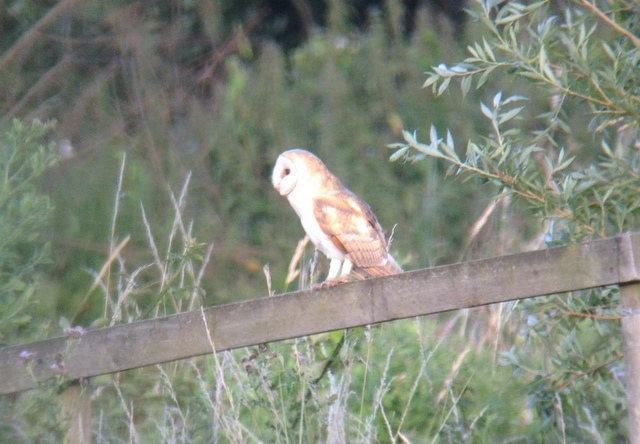 Barn Owl – our first of the evening, perched on a fence
Barn Owl – our first of the evening, perched on a fence
A little further round, and we stopped again and set off to walk out over the marshes. Almost immediately we spotted another Barn Owl, flying across over the reeds. There is a Barn Owl box here and once we had walked out a little further we could see two more owls around the box. One of them was just in the process of devouring a vole. As we watched, it was clear there was an adult bird bringing back food, and 2-3 freshly fledged juveniles still sitting round the entrance to the box waiting to be fed.
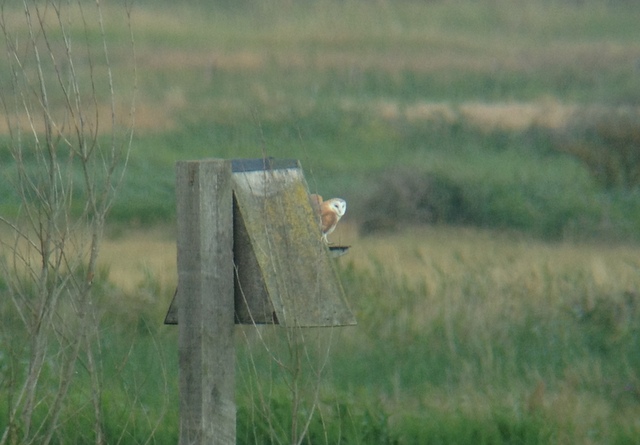 Barn Owls – 2-3 juveniles were waiting to be fed at the entrance to the box
Barn Owls – 2-3 juveniles were waiting to be fed at the entrance to the box
While we were scanning over the grazing marshes, another Barn Owl appeared from nowhere right in front of us, flying in from the direction of the road. It worked its way methodically round the edge of the field, looking purposefully down into the grass all the time. Then it suddenly dropped down after something. It came up again with a vole in its talons, and set off back towards the village, flying straight past us on its way. We got a fantastic view of it. A little while later, it came back again and resumed hunting, presumably having fed its young.
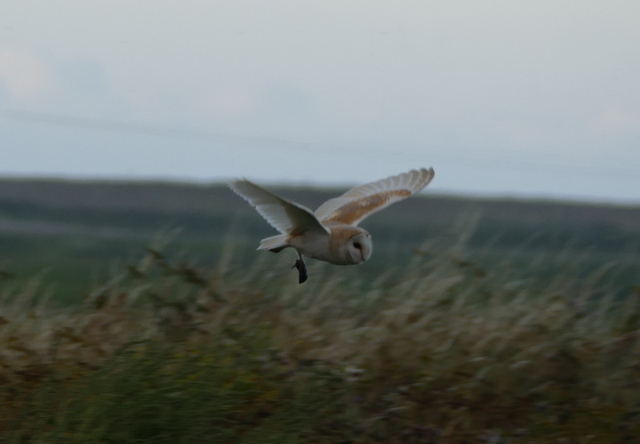 Barn Owl – carrying food back to its youngsters
Barn Owl – carrying food back to its youngsters
Back at the box, one of the adult Barn Owls flew back across the marshes with some prey in its talons. However, instead of going straight into the box to feed the juveniles, it landed on a post down in the reeds in front. It didn’t seem to show any interest in eating its vole itself, so was presumably trying to tempt the young Barn Owls out to fly round. They were not showing any inclination to leave the comfort of the box!
While we were watching the Barn Owls, we could hear Bearded Tits calling from the reeds. Looking more closely, we could see some movement further over, so we walked round for a better look. It didn’t take long to pick up three juveniles – they were rather vocal and kept edging their way up to the tops of the reeds before dropping back in or flying across the tops.
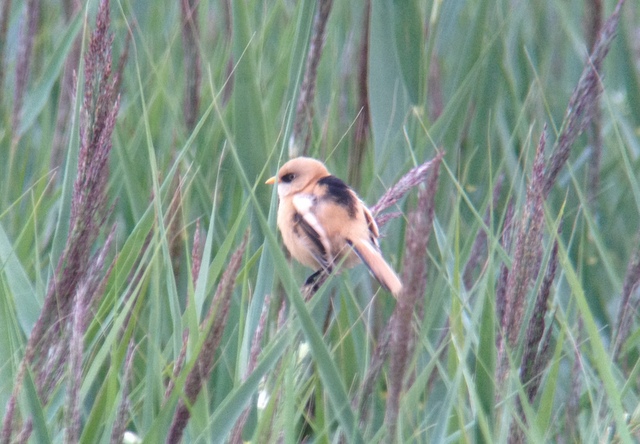 Bearded Tit – a good performance from several juveniles this evening
Bearded Tit – a good performance from several juveniles this evening
Then it was time to tear ourselves away and head up to the heath for the evening’s main event. It had started to cloud over again a little while we were out on the marshes and was already getting dark by the time we got there, sooner than we had expected. We could already hear a Nightjar calling from the trees as we walked up. Perfect timing!
Shortly after we arrived, one of the Nightjars flew out and perched up on a stump on the edge of the trees in front of us. It sat there for some time, just looking around. We got it in the scope and got great views of it – it appeared to be a female, lacking the white flashes in wings and tail which the male shows. Eventually, it flew off into the tops of the trees, but reappeared only a few seconds later hawking for insects above our heads. We could also hear a Tawny Owl hooting in the distance.
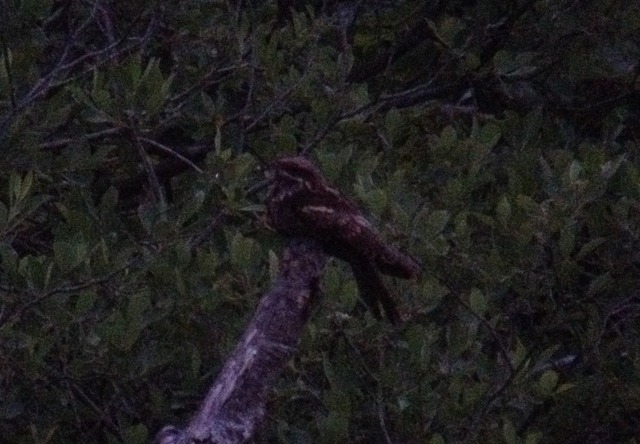 Nightjar – one of three birds we saw this evening
Nightjar – one of three birds we saw this evening
Finally a male Nightjar started churring across the other side of the heath, behind us. This prompted the male in front of us to start churring in response. The next thing we knew, a Nightjar appeared on the dead tree stump again. This time it was a male – it sat there with tail spread flashing its white tail corners – and we presumed it was the resident male we had just heard.
However, then another male Nightjar appeared from the trees and started to buzz around the male sat on the stump. It gave up and disappeared into the trees again, then came out and started flying round the stump male once more. It repeated this several times, flying into the trees, before coming back out and flying round the other male. It even tried to land on top of him a couple of times, presumably in an effort to displace the interloper and regain his song perch, but the other male simply stayed put. There are two male Nightjars here with neighbouring territories, so presumably this was the next door male trying to take over the resident male’s song perch. Finally, after several attempts, the interloper flew off down to the ground and the resident male started churring. Great behaviour to watch, real all-action stuff.
Then, as the light started to fade, it was a good time to call it a night.
